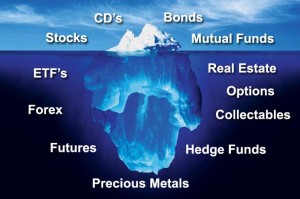Beyond the three primary asset classes where we find bonds, stocks and cash, we have many other types of investments that can be used to diversify our portfolios. These assets are called “Alternative Asset Classes” and cover a wide range of investment opportunities. The more important categories include hedge funds, private equity, natural resources, real estate, infrastructure and even emerging markets can be considered. Other investments that also fit into this category include art, antiques, ostriches, jewelry, gems, precious metals and commodities, between others.
The main distinguishing feature of these assets vis-à-vis others, is the lack of standardization in these markets. These are generally bought and sold in private markets, outside of any exchange, which do not fall under the purview of any strict regulations. These assets usually have a large initial investment, and, hence, are not viable for all investors. (Dedhia, 2011).
These unique properties also involve a higher degree risk. They highly depend on novel investing strategies or individual skills in selecting specific investments and because of the nature of the asset some have low liquidity. Finally, they have investing freedom increasing the potential for mismanagement or losses.
By the other hand, they have the advantage to offer potential returns that are not highly correlated with other markets. In the past, stocks and bonds had this traditional non-correlating behave (while one went down, often the other went up). The problem is that in the past 4 years they have displayed much more correlation.
This behavior has called into question the merits and effectiveness of what had been the foundation of prudent investing for a number of decades. (Sullivan, 2010).
Having this in mind, the fiduciaries of qualified plans (401(k)s and others) are in a particularly difficult position. Plan trustees -who have fiduciary liability-, are responsible for overseeing the investments available to participants of the plan. Typically, this is done by providing participants the ability to establish various asset allocation portfolios. Though many retirement plan fiduciaries will have to address the following conundrum If asset allocation using stocks, bonds and cash is not working (even if only for a brief period), should our plan offer alternative asset classes to the participants? (Sullivan, 2010).
The answer is not easy; one key requirement for an investor to be recommended investment in alternative assets is knowledge. A person who does not know much about the financial markets should be advised to invest in traditional assets, like stocks and mutual funds, quite safely, but when it comes to alternative assets, each of these come with their unique risk and return characteristics that should be clearly understood by the investor before venturing into it. (Dedhia, 2011).
That brings us the conclusion that people who already have a strong financial plan and have taken already care of their main life goals are candidates to lookout for this investments that behave differently form the broad equity markets.
For the future of people I think secure is the best, what do you think?
Sources:
Sullivan, Ryan (2009). Alternative Asset Classes. Are they right for your 401(k)? Retrieved on November 28, 2011 from http://www.rehmann.com
Skidmore, Gregory H. (2010). Alternative Asset Classes: An Introduction. Retrieved on November 28, 2011 from http://belrayasset.files.wordpress.com
Dedhia, Mukesh (2011, 8). Investment in Alternative Asset Classes is not for all. Retrieved on November 28, 2011 from http://www.mydigitalfc.com






Leave A Comment